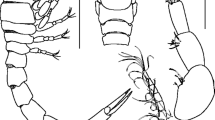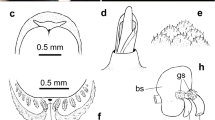Abstract
Cryptaulax? bittneri, also known asPromathildia bittneri, is frequently reported to be present in Late Triassic biotas and is cited as a species with almost cosmopolitan distribution (S-Alps, S-America, Iran, Karakorum). Re-examination of the holotype of the species shows that nearly all reports are based on misidentifications. This species is known only from the holotype and thus it is known only from its type locality, the Cassian Formation (S-Alps, Italy). Frequent misidentifications show thatCryptaulax bittneri is poorly known and therefore the holotype is figured and redescribed. It is one of the earliest cerithioid gastropods that has a complex teleoconch ornament typical of many modern Cerithioidea. This complex ornament of axial ribs and spiral cords with knobby intersections could represent an early aspect of the Mesozoic marine revolution. A complex teleoconch ornament and a carinated larval shell could represent apomorphies of the Mesozoic Procerithiidae, since these characters are absent in the known Palaeozoic Cerithimorpha. The Recent genusArgyropeza is so similar to the procerithiid genusCryptaulax thatArgyropeza can be considered to represent a living fossil.Xystrella inaequelineata Nützel & Senowbari-Daryan 1999 from the Late Triassic Nayband Formation of central Iran is transferred toCryptaulax.
Kurzfassung
Cryptaulax? bittneri, auch bekannt alsPromathildia bittneri, gilt als häufig in obertriassischen Faunen auftretende Art; angeblich ist sie nahezu kosmopolitisch verbreitet (Südalpen, Südamerika, Iran, Karakorum). Eine Überprüfung des Holotyps der Art ergab, dass fast alle Berichte auf Fehlbestimmungen beruhen. Diese Art ist lediglich durch den Holotypus von der Typlokalität aus den Cassianer Schichten (Südalpen, Italien) bekannt. Die zahlreichen Fehlbestimmungen zeigen, dassCryptaulax? bittneri eine unzureichend bekannte Art ist und deshalb wird der Holotyp neu abgebildet und beschrieben. Es handelt sich um eine der ältesten Cerithioideen mit komplexer Skulptur des Teleoconchs, die typisch für viele moderne Cerithioidea ist. Diese komplexe Skulptur besteht aus Axialrippen und spiraligen Wülsten, deren Kreuzungspunkte knotig verdickt sind. Sie stellt wahrscheinlich einen frühen Aspekt der mesozoischen marinen Revolution dar. Der komplex skulptierte Teleoconch und eine carinate Larvalschale könnten Apomorphien der mesozoischen Procerithiidae sein, da diese Merkmale bei den bisher bekannten paläozoischen Cerithimorpha fehlen. Die rezente GattungArgyropeza ist der procerithiiden GattungCryptaulax so ähnlich, dassArgyropeza als lebendes Fossil angesehen werden kann.Xystrella inaequelineata Nützel & Senowbari-Daryan 1999 aus der obertriassischen Nayband Formation Zentralirans wird in die GattungCryptaulax gestellt.
Similar content being viewed by others
Literature
Bandel, K. 1992. Über Caenogastropoden der Cassianer Schichten (Obertrias) der Dolomiten (Italien) und ihre taxonomische Bewertung. - Mitteilungen aus dem Geologisch-Paläontologischen Institut der Universität Hamburg73: 37–97.
Bandel, K. 1993. Caenogastropoda during Mesozoic times. - Scripta Geologica, Special issue2: 7–56.
Bandel, K. 1994. Comparison of Upper Triassic and Lower Jurassic Gastropods from the Peruvian Andes (Pucará Group) and the Alps (Cassian Formation). - Palaeontographica A233: 127–160.
Batten, R.L. 1985. Permian gastropods from Perak, Malaysia. Part 3. The murchisoniids, cerithiids, loxonematids, and subulitids. - American Museum Novitates2829: 1–40.
Cossmann, M. 1906. Essais de Paléoconchologie comparée. Livraison 7. - 261 p., Paris.
Cossmann, M. 1913. Contribution a la Paléontologie Française des terrains Jurassiques. III. Cerithiacea et Loxonematacea. - Mémoires de la Société Géologique de France. Paléontologie46: 89–264.
Cox, L.R. 1959. Thoughts on the classification of the Gastropoda. - Proceedings of the Malacological Society of London33: 239–261.
Cox, L.R. 1965. Gastéropodes Jurassiques du sud-est Tunisien. - Annales de Paléontologie (Invertébrés)40: 243–268.
Deslongchamps, M.E. 1842. Mémoir sur les Cérites fossiles des termines secondaires du Calvados. -Mémoires de la Société Linnéenne de Normandie7: 189–214.
Douglas, J.A. 1929. A marine Triassic fauna from Eastern Persia. - The Quarterly Journal of the Geological Society of London85: 624–648.
Gerasimov, P.A. 1992. Gastropody yurskikh i pogranicknjkh nizhnemelovykh otlozhenii evropeiskoi Rusii (Jurassic and boundary Lower Cretacous gastropods of the European part of Russia). - 190 p., Moscow (Nauka Publishers).
Goldfuss, A. 1844. Petrefacta Germaniae, Part 3. - 21–128, pl. 172–200, Düsseldorf (Arnz & Co.).
Golikov, A.N. &Starobogatov, Y.I. 1975. Systematics of prosobranch gastropods. - Malacologia15: 185–232.
Gründel, J. 1974. Bemerkungen zur Fassung der GattungProcerithium Cossmann, 1902 undCryptaulax Tate, 1869 (Gastropoda, Cerithiacea) im Jura. - Zeitschrift für geologische Wissenschaften2: 729–733.
Gründel, J. 1976. Zur Taxonomie und Phylogenie derBittium- Gruppe. - Malakologische Abhandlungen, Staatliches Museum für Tierkunde in Dresden3: 33–59.
Gründel, J. 1999. Procerithiidae (Gastropoda) aus dem Lias und Dogger Deutschlands und Polens. - Freiberger Forschungshefte C481: 1–37.
Gründel, J. &Nützel, A. 1998. Gastropoden aus dem oberen Pliensbachium (Lias d, Zone desPleuroceras spinatum) von Kalchreuth östlich Erlangen. - Mitteilungen der Bayrischen Staatssammlung38: 63–96.
Haas, O. 1953. Mesozoic invertebrate faunas of Peru. - Bulletin of the American Museum of Natural History101: 1–328.
Hebert, M. &Deslongchamps, M.E. 1860. Memoir sur les Fossiles de Montreuil-Bellay (Maine-et-Loire). lre. Partie. Céphalopodes et Gastéropodes. - Bulletin de la Société Linnéenne de Normandie5: 153–240.
Houbrick, R.S. 1988. Cerithioidean Phylogeny. - In:Ponder, W.F., ed., Prosobranch phylogeny. Proceedings of a symposium held at the 9th International Malacological Congress, Edinburgh, Scotland. - Malacological Review, Supplement4:88-128.
Houbrick, R.S. 1993. Phylogenetic relationships and a generic review of the Bittiinae (Prosobranchia: Cerithioidea). -Malacologia35: 261–313.
Jaworski, E. 1923. Die marine Trias in Südamerika. - Neues Jahrbuch für Mineralogie, Geologie und Paläontologie, Beilage-Band47: 93–200.
Kittl, E. 1894. Die Gastropoden der Schichten von St. Cassian der südalpinen Trias. III. Theil. - Annalen des Kaiserlich-Königlichen Naturhistorischen Hofmuseums9: 143–277.
Kittl, E. 1895. Die triadischen Gastropoden der Marmolata und verwandter Fundstellen in den weißen Riffkalken Südtirols. - Jahrbuch der Kaiserlich-Königlichen Geologischen Reichsanstalt44: 99–182.
Kowalke, T. 1998. Bewertung protoconchmorphologischer Daten basaler Caenogastropoda (Cerithiimorpha und Littorinimorpha) hinsichtlich ihrer Systematik und Evolution von der Kreide bis rezent. - Berliner Geowissenschaftliche Abhandlungen E27: 1–121.
Leonardi, P. &Fiscon, F. 1959. La fauna Cassiana di Cortina d’Ampezzo. ParteIII Gasteropodi. -Ricerce Geo-Paleontologiche nelle Dolomiti. - Memorie degli Istituti di Geologia e Mineralogia dell’Università di Padova21: 1–103.
Melvill, J.C. &Standen, R. 1901. The Mollusca of the Persian Gulf, Gulf of Oman and Arabian Sea, as evidenced mainly through the collections of Mr F.W. Townsend, 1893–1900; with descriptions of new species I: Cephalopoda, Gastropoda, Scaphopoda. - Proceedings of the Zoological Society of London2: 327–460.
Nützel, A. 1998. Über die Stammesgeschichte der Ptenoglossa (Gastropoda). - Berliner Geowissenschaftliche Abhandlungen E26: 1–229.
Nützel, A. &Bandel, K. 2000. Goniasmidae and Orthonemidae, two new families of the Palaeozoic Caenogastropoda (Mollusca, Gastropoda). - Neues Jahrbuch für Geologie und Paläontologie, Monatshefte2000 (9): 557–569.
Nützel, A. &Kiessling, W. 1997. Gastropoden aus dem Amaltheenton (oberes Pliensbachium) Frankens. -Geologische Blätter für Nordost-Bayern47: 381–414.
Nützel, A. &Senowbari-Daryan, B. 1999. Gastropods from the Upper Triassic (Norian-Rhaetian) Nayband Formation of central Iran. - Beringeria23: 93–132.
Pan Hua-zhang 1998. Some fossil gastropods from Karakorum-Kunlun Region. - In: Palaeontology of the Karakorum-Kunlun Mountains: 285–298, Beijing (Science Press).
Ponder, W.F. &Lindberg, D.R. 1997. Towards a phylogeny of gastropod molluscs: an analysis using morphological characters. - Zoological Journal of the Linnean Society119: 83–265.
Schröder, M. 1995. Frühontogenetische Schalen jurassischer und unterkretazischer Gastropoden aus Norddeutschland und Polen. - Palaeontographica A283: 1 -95.
Signor, P.W. 1982. Constructional morphology of gastropod ratchet sculpture. - Neues Jahrbuch für Geologie und Paläontologie, Abhandlungen163: 349–368.
Tate, R. 1869. Contributions to Jurassic Palaeontology. 1.Cryptaulax, a new genus of the Cerithiadae. - Annals and Magazine of Natural History4: 417–419.
Tracey, S.; Todd, J.A. &Erwin, D.H. 1993. Mollusca: Gastropoda. - In:Benton, M.J., ed., The Fossil Record 2 (Chapter 8): 131–167, London.
Vermeij, G.J. 1977. The Mesozoic marine revolution: Evidence from snails, predators, and grazers. - Paleobiology3: 245–258.
Vermeij, G.J. 1987. Evolution and escalation: an ecological history of life. - 527 p., Princeton, New Jersey (Princeton University Press).
Zardini, R. 1978. Fossili Cassiani (Trias Medio-Superiore). Atlante dei Gasteropodi della formazione di S. Cassiano raccolti nella regione Dolomitica attorno a Cortina d’Ampezzo. - 58 p., Cortina d’Ampezzo (Edizione Ghedina).
Zardini, R. 1980. Fossili Cassiani (Trias Medio-Superiore). Primo aggiornamento all’Atlante dei Gasteropodi della formazione di S. Cassiano raccolti nella regione Dolomitica attorno a Cortina D’Ampezzo. - 14 p., Cortina d’Ampezzo (Edizione Ghedina).
Zardini, R. 1985. Fossili Cassiani (Trias Medio-Superiore). Primo aggiornamento all’Atlante dei Bivalvi e secondo aggiornamento all’Atlante Gasteropodi della formazione di S. Cassiano raccolti nella regione Dolomitica attorno a Cortina D’Ampezzo. -17 p., Cortina d’Ampezzo (Edizione Ghedina).
Author information
Authors and Affiliations
Corresponding author
Rights and permissions
About this article
Cite this article
Nützel, A. The Late Triassic speciesCryptaulax? bittneri (Mollusca: Gastropoda: Procerithiidae) and remarks on early aspects of the Mesozoic marine revolution. Paläont. Z. 76, 57–63 (2002). https://doi.org/10.1007/BF02988185
Received:
Accepted:
Issue Date:
DOI: https://doi.org/10.1007/BF02988185
Keywords
- Gastropoda
- Cerithioidea
- Procerithiidae
- Triassic
- Cassian Formation
- Morphology
- Mesozoic Marine Revolution
- Taxonomy




